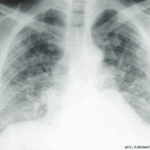Guidance for diagnosing and treating interstitial lung disease complications
Search results for: interstitial lung disease
A Spotlight on IgG4-Related Disease
What rheumatologists need to know about identifying and diagnosing immunoglobulin G4-related disease (IgG4-RD)
ACR/ARHP Annual Scientific Meeting Plenary Highlights Targets and Treatments for Several Diseases
Promising therapeutic targets for rheumatic diseases were the focus of a plenary session here at the ACR/ARHP 2011 Annual Scientific Meeting in November. Presenters discussed discoveries and treatments for systemic sclerosis, rheumatoid arthritis, vasculitis, and Behçet’s disease.
Dr. Wolfe & the National Data Bank for Rheumatic Diseases (NBD)
A private database becomes a national resource

Why Target B Cells in SSc-ILD?
In a recent Arthritis & Rheumatology review article, three experts discuss the use of immunosuppressants to target B cells in a patient with systemic sclerosis-interstitial lung disease.

The Rheumatic Dangers of Wildfire Smoke
A recent study in A&R identifies an association between air pollutants, including fire smoke particulate matter, & both rheumatoid arthritis (RA) & RA-associated interstitial lung disease.

Air Pollution May Increase the Risk of RA & RA-Associated ILD
Exposure to air pollution, such as high levels of particulate matter from fire smoke and fossil fuel-related nitrogen oxides, may increase the risk of rheumatoid arthritis (RA) and RA-associated interstitial lung disease (ILD), according to Kronzer et al. Their findings highlight the need for improved monitoring of air pollutants and suggest that addressing air pollution may help prevent RA and RA-associated ILD.

The ACR and CHEST Release 2 New ILD Guidelines
Clinicians should not rely on glucocorticoids as a first-line treatment of SARD-ILD in patients with systemic sclerosis, according to a strong recommendation in a new ILD treatment guideline from the ACR and CHEST. The guideline is one of two addressing the screening, monitoring and treatment of patients with interstitial lung disease (ILD) secondary to systemic autoimmune rheumatic diseases (SARDs).

FDA Approves Tocilizumab to Treat Systemic Sclerosis-Associated ILD
Subcutaneous tocilizumab is the first biologic agent approved by the FDA treat patients with systemic sclerosis-associated interstitial lung disease.
A Combined Immunosuppressive Regimen for ILD MDA5-Positive Dermatomyositis
Interstitial lung disease accompanied by anti-melanoma differentiation-associated gene 5 positive dermatomyositis is often rapidly progressive and associated with poor prognosis. In this study, a combined immunosuppressive regimen of high-dose glucocorticoids, tacrolimus and intravenous cyclophosphamide proved more effective than treatment with high-dose glucocorticoids and stepwise addition of an immunosuppressant in a historical control group.
- « Previous Page
- 1
- …
- 6
- 7
- 8
- 9
- 10
- …
- 27
- Next Page »